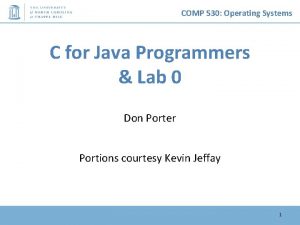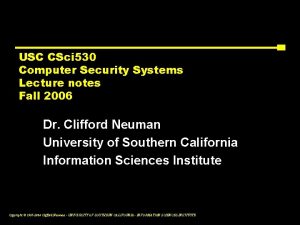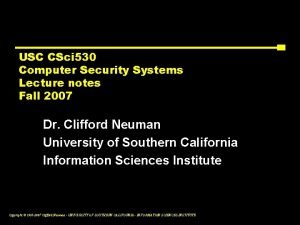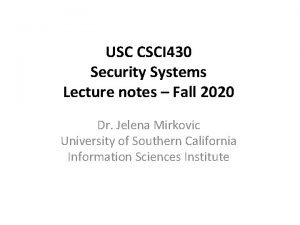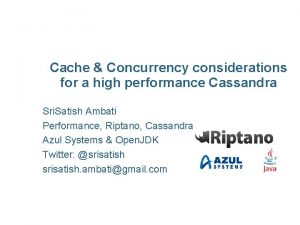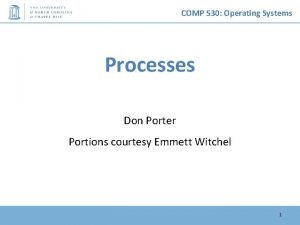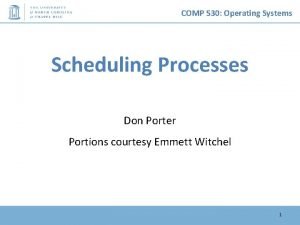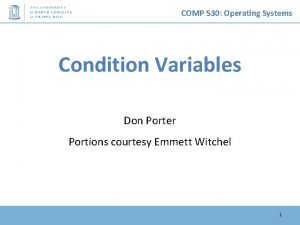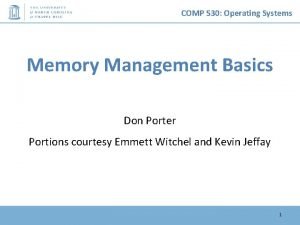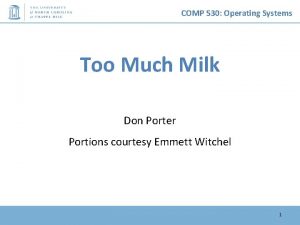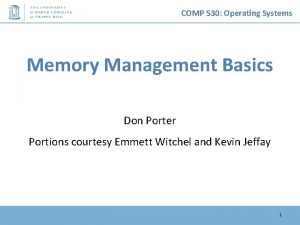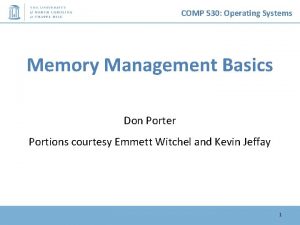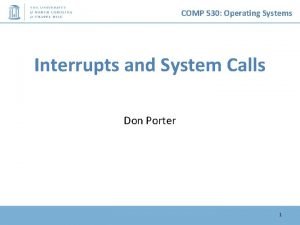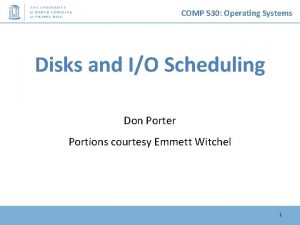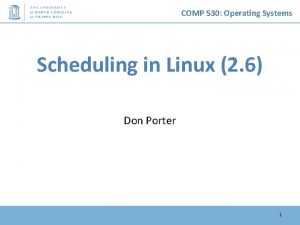COMP 530 Operating Systems Locking Don Porter Portions























- Slides: 23

COMP 530: Operating Systems Locking Don Porter Portions courtesy Emmett Witchel 1

COMP 530: Operating Systems Too Much Milk: Lessons • Software solution (Peterson’s algorithm) works, but it is unsatisfactory – Solution is complicated; proving correctness is tricky even for the simple example – While thread is waiting, it is consuming CPU time – Asymmetric solution exists for 2 processes. • How can we do better? – Use hardware features to eliminate busy waiting – Define higher-level programming abstractions to simplify concurrent programming

COMP 530: Operating Systems Concurrency Quiz If two threads execute this program concurrently, how many different final values of X are there? Initially, X == 0. Thread 1 Thread 2 void increment() { int temp = X; temp = temp + 1; X = temp; } Answer: A. 0 B. 1 C. 2 D. More than 2

COMP 530: Operating Systems Schedules and Interleavings • Model of concurrent execution • Interleave statements from each thread into a single thread • If any interleaving yields incorrect results, some synchronization is needed Thread 1 Thread 2 tmp 1 = X; tmp 2 = tmp 2 + 1; tmp 1 = tmp 1 + 1; tmp 2 = tmp 2 X+ =1; tmp 2; X = tmp 1; tmp 1 = tmp 1 + 1; X = tmp 2; If X==0 initially, X == 1 at the end. WRONG result!

COMP 530: Operating Systems Locks fix this with Mutual Exclusion void increment() { lock. acquire(); int temp = X; temp = temp + 1; X = temp; lock. release(); } • Mutual exclusion ensures only safe interleavings – When is mutual exclusion too safe?

COMP 530: Operating Systems Introducing Locks • Locks – implement mutual exclusion – Two methods • Lock: : Acquire() – wait until lock is free, then grab it • Lock: : Release() – release the lock, waking up a waiter, if any • With locks, too much milk problem is very easy! – Check and update happen as one unit (exclusive access) Lock. Acquire(); if (no. Milk) { buy milk; } Lock. Release(); Lock. Acquire(); x++; Lock. Release(); How can we implement locks?

COMP 530: Operating Systems How do locks work? • Two key ingredients: – A hardware-provided atomic instruction • Determines who wins under contention – A waiting strategy for the loser(s) 7

COMP 530: Operating Systems Atomic instructions • A “normal” instruction can span many CPU cycles – Example: ‘a = b + c’ requires 2 loads and a store – These loads and stores can interleave with other CPUs’ memory accesses • An atomic instruction guarantees that the entire operation is not interleaved with any other CPU – x 86: Certain instructions can have a ‘lock’ prefix – Intuition: This CPU ‘locks’ all of memory – Expensive! Not ever used automatically by a compiler; must be explicitly used by the programmer 8

COMP 530: Operating Systems Atomic instruction examples • Atomic increment/decrement ( x++ or x--) – Used for reference counting – Some variants also return the value x was set to by this instruction (useful if another CPU immediately changes the value) • Compare and swap – if (x == y) x = z; – Used for many lock-free data structures 9

COMP 530: Operating Systems Atomic instructions + locks • Most lock implementations have some sort of counter • Say initialized to 1 • To acquire the lock, use an atomic decrement – If you set the value to 0, you win! Go ahead – If you get < 0, you lose. Wait – Atomic decrement ensures that only one CPU will decrement the value to zero • To release, set the value back to 1 10

COMP 530: Operating Systems Waiting strategies • Spinning: Just poll the atomic counter in a busy loop; when it becomes 1, try the atomic decrement again • Blocking: Create a kernel wait queue and go to sleep, yielding the CPU to more useful work – Winner is responsible to wake up losers (in addition to setting lock variable to 1) – Create a kernel wait queue – the same thing used to wait on I/O • Reminder: Moving to a wait queue takes you out of the scheduler’s run queue 11

COMP 530: Operating Systems Which strategy to use? • Main consideration: Expected time waiting for the lock vs. time to do 2 context switches – If the lock will be held a long time (like while waiting for disk I/O), blocking makes sense – If the lock is only held momentarily, spinning makes sense • Other, subtle considerations we will discuss later 12

COMP 530: Operating Systems Reminder: Correctness Conditions • Safety – Only one thread in the critical region • Liveness – Some thread that enters the entry section eventually enters the critical region – Even if other thread takes forever in non-critical region • Bounded waiting – A thread that enters the entry section enters the critical section within some bounded number of operations. • Failure atomicity – It is OK for a thread to die in the critical region – Many techniques do not provide failure atomicity

COMP 530: Operating Systems Example: Linux spinlock (simplified) 1: lock; decb slp->slock jns 3 f 2: pause cmpb $0, slp->slock jle 2 b jmp 1 b 3: // Locked decrement of lock var // Jump if not set (result is zero) to 3 // Low power instruction, wakes on // coherence event // Read the lock value, compare to zero // If less than or equal (to zero), goto 2 // Else jump to 1 and try again // We win the lock 14

COMP 530: Operating Systems Rough C equivalent while (0 != atomic_dec(&lock->counter)) { do { // Pause the CPU until some coherence // traffic (a prerequisite for the counter // changing) saving power } while (lock->counter <= 0); } 15

COMP 530: Operating Systems Why 2 loops? • Functionally, the outer loop is sufficient • Problem: Attempts to write this variable invalidate it in all other caches – If many CPUs are waiting on this lock, the cache line will bounce between CPUs that are polling its value • This is VERY expensive and slows down EVERYTHING on the system – The inner loop read-shares this cache line, allowing all polling in parallel • This pattern called a Test&Set lock (vs. Test&Set) 16

COMP 530: Operating Systems Test & Set Lock // Has lock CPU 0 while (!atomic_dec(&lock->counter)) Write Back+Evict Cache Line Cache 0 x 1000 CPU 1 atomic_dec CPU 2 atomic_dec Cache Memory Bus 0 x 1000 RAM Cache Line “ping-pongs” back and forth 17

COMP 530: Operating Systems Test & Set Lock // Has lock while (lock->counter <= 0)) Unlock by writing 1 CPU 0 CPU 1 read Cache 0 x 1000 CPU 2 read Cache Memory Bus 0 x 1000 RAM Line shared in read mode until unlocked 18

COMP 530: Operating Systems Why 2 loops? • Functionally, the outer loop is sufficient • Problem: Attempts to write this variable invalidate it in all other caches – If many CPUs are waiting on this lock, the cache line will bounce between CPUs that are polling its value • This is VERY expensive and slows down EVERYTHING on the system – The inner loop read-shares this cache line, allowing all polling in parallel • This pattern called a Test&Set lock (vs. Test&Set) 19

COMP 530: Operating Systems Implementing Blocking Locks Lock: : Acquire() { while (test&set(lock) == 1) ; // spin } With busy-waiting Lock: : Release() { *lock : = 0; } Lock: : Acquire() { while (test&set(q_lock) == 1) { Put TCB on wait queue for lock; Lock: : Switch(); // dispatch thread } Without busy-waiting, use a queue Lock: : Release() { *q_lock = 0; if (wait queue is not empty) { Move 1 (or all? ) waiting threads to ready queue; } Must only one thread be awakened? Is this code fair?

COMP 530: Operating Systems Best Practices for Lock Programming • When you enter a critical region, check what may have changed while you were spinning – Did Jill get milk while I was waiting on the lock? • Always unlock any locks you acquire

COMP 530: Operating Systems Implementing Locks: Summary • Locks are higher-level programming abstraction – Mutual exclusion can be implemented using locks • Lock implementations have 2 key ingredients: – Hardware instruction: atomic read-modify-write – Blocking mechanism • Busy waiting, or – Cheap Busy waiting important • Block on a scheduler queue in the OS • Locks are good for mutual exclusion but weak for coordination, e. g. , producer/consumer patterns.

COMP 530: Operating Systems Why locking is also hard (Preview) • Coarse-grain locks – – Simple to develop Easy to avoid deadlock Few data races Limited concurrency // WITH FINE-GRAIN LOCKS void move(T s, T d, Obj key){ LOCK(s); LOCK(d); tmp = s. remove(key); d. insert(key, tmp); UNLOCK(d); UNLOCK(s); } • Fine-grain locks – Greater concurrency – Greater code complexity – Potential deadlocks • Not composable – Potential data races • Which lock to lock? Thread 0 move(a, b, key 1); Thread 1 move(b, a, key 2); DEADLOCK!
 Comp 530
Comp 530 Comp 530
Comp 530 Csci 530
Csci 530 Csci 530
Csci 530 Csci 430
Csci 430 Explain miss maudie's cake portions
Explain miss maudie's cake portions Explain miss maudie's cake portions
Explain miss maudie's cake portions Lateral directional term
Lateral directional term Chapter 5 the skeletal system axial skeleton skull
Chapter 5 the skeletal system axial skeleton skull Chapter 5 the skeletal system figure 5-10
Chapter 5 the skeletal system figure 5-10 Seafile roadmap
Seafile roadmap Cassandra optimistic locking
Cassandra optimistic locking Curriculum guide for driver education in virginia module 3
Curriculum guide for driver education in virginia module 3 Personal fall arrest snap hooks must be locking and be
Personal fall arrest snap hooks must be locking and be Locking movements
Locking movements Chafing blocks fire hose
Chafing blocks fire hose What are two pitfalls (problems) of lock-based protocols
What are two pitfalls (problems) of lock-based protocols Types of fasteners
Types of fasteners File and record locking in network programming
File and record locking in network programming Phase locking
Phase locking Knee locking mechanism
Knee locking mechanism Non positive locking devices
Non positive locking devices Locks in dbms
Locks in dbms For flat pivot bearing the rate of wearing
For flat pivot bearing the rate of wearing
